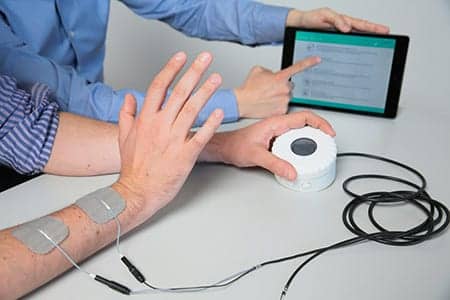
The Intento device is designed to enable patients to control the functional electronic stimulation that they receive, to help them regain mobility in arms weakened by a stroke.
A device from Ecole Polytechnique Fédérale de Lausanne startup company Intento is designed to enable stroke patients to self-administer functional electrical stimulation to help regain mobility in their arms weakened by the stroke.
The system consists of electrode patches, a device the patients control using their working hand, and tablet software. The therapist selects one of several programmed movements on the tablet and loads it, with a single click, onto the device. The program shows where the electrodes need to be placed and automatically configures the electrical pulse settings to generate the desired movement. Patients then move their functioning hand to control the electrical stimulation needed.
The ultimate aim is for patients to eventually perform the movements without using the device, explains a media release from Ecole Polytechnique Fédérale.
Results from a study investigating Intento’s device were published recently in Archives of Physical Medicine and Rehabilitation.
In the study, researchers from Lausanne University Hospital (CHUV) compared the device to conventional occupational therapy among 11 patients who were severely paralyzed as the result of a stroke. These patients experienced the stroke more than 6 months prior to the study, and other therapies did not work for them.
Over a period of 10 days, the 11 patients underwent 1.5-hour sessions using the Intento device.
Their mobility results from using the device were then compared to the results following conventional occupational therapy conducted over the same amount of time. The patients’ mobility was measured before and after each type of treatment, according to the release.
The results suggest that 70% of the patients experienced significant improvement in their motor functions, versus only 30% of the patients with the conventional occupational therapy.
“Above and beyond the study’s findings, several of the patients told us a few weeks later that they were already using their arms more than before,” says Andrea Maesani, Intento’s CEO and other cofounder, in the release.
Patients were still making steady progress 6 months after the study was conducted, suggesting that the treatment produces long-term effects, according to the release.
The next step will be a clinical study on a larger group before marketing the device, the founders state in the release.
[Source(s): Ecole Polytechnique Fédérale, EurekAlert]



